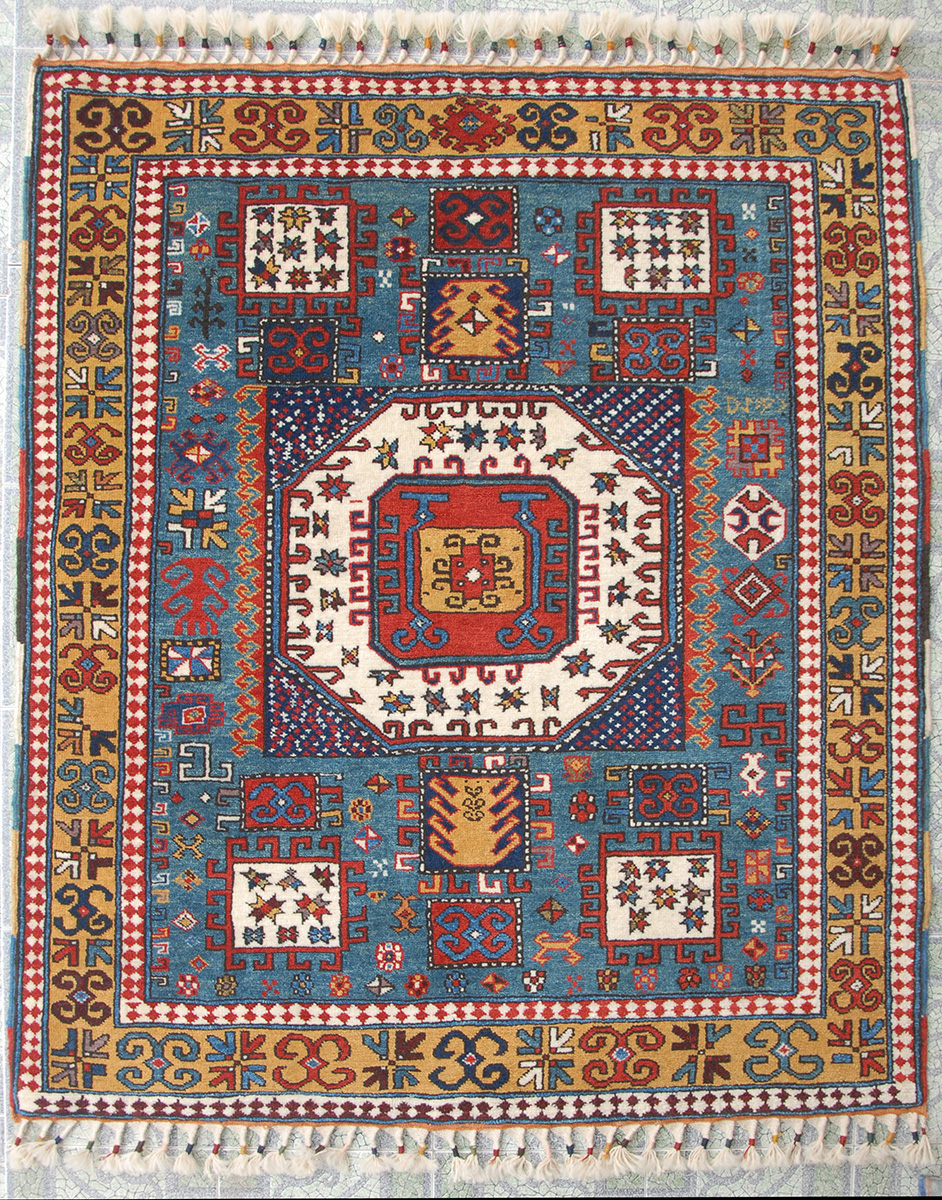Kazak Karachop rug
Code:
KZKCH22M
Size: 140x160cm
Size (ft): 4'7"x5'2"
Area: 2.24 m2
Density: 105 000 knots per square meter, totally ~230 000 knots
Colors: aqua green, red, yellow, medium blue, dark blue,
burgundy, old purple, dark brown, ivory, olive, pale brown, cinnamon.
Dyes:
madder,
weld
(Reseda Luteola),
onion skins, cochineal, indigo,
pomegranate skins,
walnut husks,
natural dark brown sheep wool, natural ivory sheep wool, natural medium
brown sheep wool.
Materials: Handcarded and handspun wool for pile, ivory wool warps
(natural ivory and brown twist) and
light red wool wefts (two shots, dyed with onion skins and madder). 1cm of flatwoven kilim ends at both sides.
- wool on wool
Knots: Gördes (Turkish, symmetrical)
Pile height: 0.7cm
End finishs: Horizontal band of two-pick oblique
interlacing warps. Braided fringes.
Inscriptions: weaving date, the word "Umay" in
Orhon-Yenisey scripts ("Umay" is a female spirit that that protects babies
in Turkic mythology. She is also a bringer of luck, abundance and
fertility)
Weaver: Sevinj
Weaving Period:
Four months
Handwoven in Azerbaijan
Design: The aqua green
field scattered with various polychrome hooked squares containing stellar
flowerheads and geometric motifs around a central rectangular panel
containing an ivory octagon with similar small sqaure panels and minor
geometric motifs. Tree of life, swastika, rams horn, memlings Gul and
other tribal motifs are woven around the central field.
The main border depicts rams horn and "four arrows" motif.
The design motifs are assembled by Vugar Dadashov.
Karachop pattern has most probable pre-Islamic totemic sources which it
shares with the Turkoman göl. Over the period from which examples are
available, the design of the Karachop rugs basically remained, stable
geometric designs, possibly because it was ancient adaptation of Central
Asian totemic themes. Many symmetrical design elements to be pointed on
the north/south or vertical axis and blunted on the east/west or
horizontal axis can be found commonly in rugs of Turkic speaking people:
Turkmen, Shahsavan, Azebaijani, Turkish etc. A 'proto-Karachop'
(McMullan, plate 98) from western Turkey shows four pairs of red stylized
animals in the central octagonal medallion, surrounded by four minor
medallions edged with typical Turkoman-style kotshak forms. Most probably
it had a south Caucasian contemporary, but no example is known. The
earliest Karachops, like other early Kazaks, are finely knotted and not
very large. They have either a red or green field, and a dark purple color
is almost always present.
Subsidiary figures which are found at each end, in the 2-1-2 format, can
also let us to trace the lineage of the Karachops back to the Holbein
carpets and Ushaks. Following is an image of a 16th Century Holbein Type
IV rug from the Museum of Islamic and Turkish Arts in Istanbul
illustrating this relationship:
Information about the Karachop village:
Karachöp is the name of a
district with eight villages in Kakheti province, Georgia. The name of
these villages are Yor-Mughanli, Tüller, Lambali, Kesheli, Düzeyremi,
Qarabaghli, Qazylar and Baldo. These villages are inhabited by Karapapakh
Turks. This is the ethnic group who is responsible for the weaving of the
historical Karachop rugs. The names of these villages are taken from the
sub-groups of the Karapapakh tribe.


Karachop village |
Note: KARAPAPAKH (Turkish, "black hat"), a Turkic people whose language
belongs to the western Oghuz division. They are of mixed Kypchak and Oghuz
origin.
|





.jpg)
.jpg)
.jpg)
.jpg)
.jpg)
.jpg)
.jpg)
.jpg)
.jpg)
.jpg)
.jpg)

